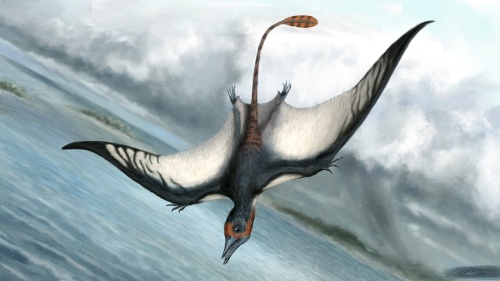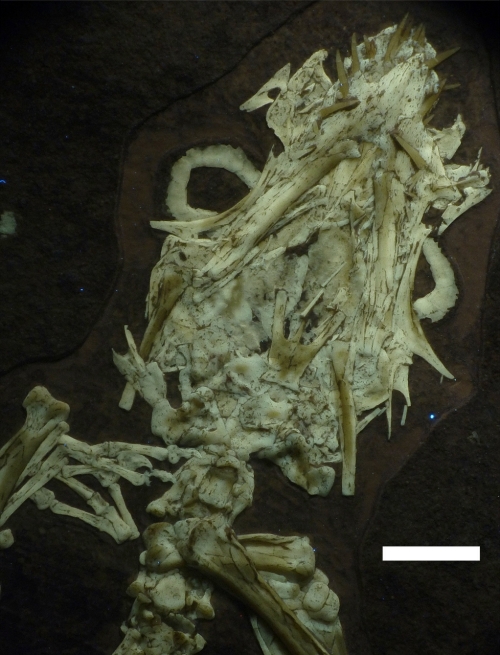Visitors to the Solnhofen Museum in Germany in recent years might well have seen a delightful specimen of a small Rhamphorhynchus on display. While clearly a nice little find, it was hard to see too much detail under the glass given how a) small it was and b) just how close in colour the bones were to the matrix it was preserved in. Certainly I didn’t give it much more than a glance when I first saw it as part of the Flugsaurier fieldtrip way back in 2007, and I’m not sure that many of my colleagues did either (though to be fair we had only an hour or two to try and do the whole museum, and well, if you work on pterosaurs you generally have seen a lot of Rhamphorhynchus material).
However, while I was in Dublin, a PhD student working on Solnhofen jellyfish pointed me back to this as something worthy of more special interest. Once I had some decent photos of it, it was clear that it was indeed something rather more special than just a young and complete specimen of Rhamphorhynchus. Indeed, while clearly having a lot in common with this very well known genus, there were some obvious and pretty significant differences. Talking to the curator at the Solnhofen, Martin Roeper, I discovered that (perhaps inevitably) Helmut Tischlinger had already taken a number of UV images of the material and he and Dino Frey had planned to work on it, but things had fallen behind. A few more exchanges and I was generously offered the chance to lead the formal description of the material and write up this interesting find.
That paper has now been completed and indeed published, and as such the inconveniently labelled specimen BSP–1993–XVIII–2 should now be known as Bellubrunnus rothgaengeri. The species name honours Monica Rothgaenger who led the team that uncovered the material and donated it to the museum (note that while this has a BSPG number, it is on permanent loan to the Solnhofen). The generic name comes from the locality of the matieral, Brunn, and the Latin ‘bellus’ meaning beautiful. This is the beautiful one from Brunn, and well, as you can hopefully see, it really is a superb specimen. It’s effectively complete and articulated and preserved in ventral view. While it is indeed hard to make out too much detail under normal lighting conditions, under UV, the difference between bone and matrix is obvious in the extreme and the details quite apparent and with tiny and fragile parts like the sclerotic rings, the palate, the tarsals and prepubes being preserved. Sadly though, there’s no sign of a single jot of soft tissues anywhere, despite the superb (indeed, unusually good) preservation of the bones. The matrix around the bones has been prepared right down to help expose them and you can see the scrape marks of preparation tools around the specimen.
Happily for all fans of sci comms and outreachy things, the paper is in PLoS ONE (the latest in quite a series for pterosaur work this year it must be said) and so freely available. There is, inevitably, a lot to be said about this animal and while the paper IS freely available, I think that there is a good mine of interesting things here that help reveal ideas about pterosaur evolution and anatomy. And let’s face it, even with the best will in the world, it can be hard to fight through a long paper, and it’s rather easier to read a few blog posts. That said, obviously with the paper being freely available, if you do want more details and specifics and citations etc. then the paper should be the first place you look.
This post then is perhaps not so much more than a holding pattern while obviously showing off the material itself, and this superb life reconstruction by Matt van Rooijen (which is also in the paper and so available) whom I must thank for his superb efforts. I’m not going to try and spin this out too much, but there are some nice areas of interest about Bellubrunnus that can be easily separated from the rest and make nice short and self-contained posts, so I’ll try and do just that. We’ll start almost immediately with the most obvious question – what exactly is it?





Wow that fourth wing digit phalanx is very curved and bow-like! I thought in the drawing it was just a consequence of the flapping movement.
Congratulations!
Thanks for sharing this and publishing in PLoS One. When I did stone lithography I’d fantasize about uncovering a fossil as I ground the limestone with a levigator. Amazing specimen and excellent photos.
Lovely illustration and photos. That really is a very nice specimen. I, too, am interested in knowing a little more about that final bone on the 4th digit and hope you’ll say something in a bite-sized blog post so I don’t have to wade thru the paper.
Also, quick Q, in the natural light photo of the whole specimen above there are a couple of bones oriented pretty much vertically (anterio-posterially if you prefer) – the one on the left of the photo points up at what I assume is a sclerotic ring. They look like matching pairs, are they the broken rear part of the mandible? And is the roughly V-shaped bone between the hyoid?
Thanks
Hi Mark, I’m not saying much about the wings as I hope to do a follow up paper on this, but things have stalled on that owing to recalcitrant collaborator so I’m not sure what to do. There is paragraph or two in the paper on this which should clear up any basic issues.
As for the skull, well there’s a fully labeled figure in the paper. That should clear up any identification issues you’re having.
Sorry to palm things off a bit like this but i’m super busy right now, and well, I know that it’s accessible. 🙂
Thanks, Dave, no apology necessary. I’m sure the pic will be easy enough to find.
Progress on describing the wings further has “stalled”. Not sure what angle of attack you could take with your wingman to encourage them to lift their performance, stop drag-ging their feet, and pitch in, but I wouldn’t get into a flap about it. Hopefully you can reach some sort of ac-chord! 😉
It really would be helpful if when you blogged about new papers (whether yours or others) you included the full citation at the bottom of the post!
But I did this time, and linked to the paper….